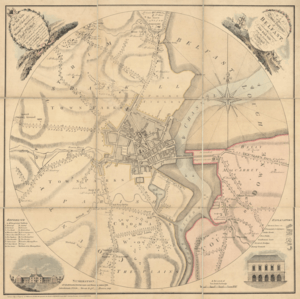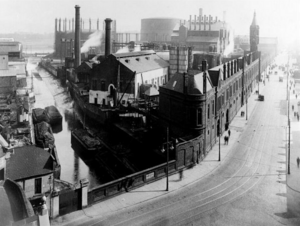Blackstaff River facts for kids
The Blackstaff River is a river in County Antrim, Northern Ireland. It starts on the eastern side of Black Mountain. The river then flows through the Bog Meadows. It passes under the city of Belfast before joining the River Lagan. Most of the Blackstaff is now hidden underground. This happened because it was built over since the 1800s. You can't see much of it today. A smaller river, the Forth or Clowney River, joins it under the Broadway Roundabout in West Belfast.
Contents
The Blackstaff River: Belfast's Hidden Waterway
The Blackstaff's Past: How It Shaped Belfast
The name Blackstaff likely comes from old, dark wooden beams. These beams might have been used to cross the river. In the Irish language, it was called Abhain Bheara or Owenvarra. This means "river of the staff."
Early Days and Challenges
Long ago, the Blackstaff flowed into the Lagan River. This was near where the Queen's Bridge is today. It also reached Victoria Square. The river formed a wide, muddy area. This area stretched up to Sandy Row. A three-arched stone bridge crossed it there. This was called the Saltwater Bridge. It stood where the Boyne Bridge is now.
In the 1600s, the Blackstaff became a problem. The new town of Belfast needed to grow. But the muddy areas on the river's south side stopped it. So, people made changes to the river. A new channel was dug at the river's mouth. This allowed boats to reach a wharf at Belfast Castle.
In the 1690s, the river was moved. It went through a new path in Cromac Wood. This is where the Gasworks are today. The Earl of Donegall ordered this work. He wanted to help local workers during a tough time. This change allowed Belfast to build new areas. Development could now happen south of Ann Street. This was the original edge of the town.
Mills, Gasworks, and Buried Waters
In 1767, Henry Joy bought land at Cromac. His family published the Belfast Newsletter. He wanted to build a paper mill there. The Blackstaff River would power this mill. The river's original outlet became a mill dam. This gave the mill extra power.
Later, the dam was drained. It became the Markets area of the city. The paper mill closed in the 1850s. The Gasworks opened nearby in 1823. They operated until the 1980s. Then, the site became a business park. The part of the Blackstaff River that ran through it was buried.
The Blackstaff stayed open until the late 1800s. But it became very dirty and polluted. In 1881, the Newsletter newspaper complained. It said the river was once clean. Now, it was "the greatest eyesore in the town." The newspaper suggested burying the river. This work happened in the next ten years. The river was hidden beneath the city. Like the nearby Farset, the Blackstaff is mostly invisible. However, some parts are still open. You can see them along the Boucher Road in west Belfast.
Keeping the River Safe: Maintenance and Floods
The Blackstaff is a "designated watercourse." This means the Department for Infrastructure looks after it. The Rivers Agency controls and maintains the river.
The Blackstaff is a big reason for flood risk in Belfast. This is especially true in low-lying areas. For example, on August 16, 2008, a new underpass flooded. This underpass carried the M1 motorway to the A12 Westlink. It flooded to about 20 feet (6 meters) deep. This happened during heavy rain. The water came from the buried Blackstaff and Clowney Rivers.




